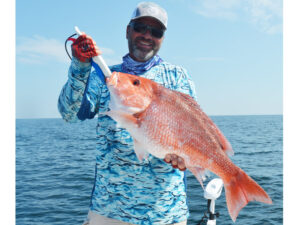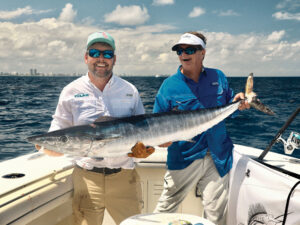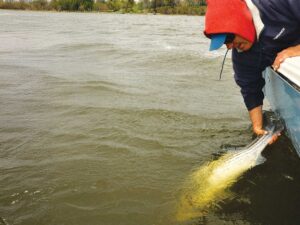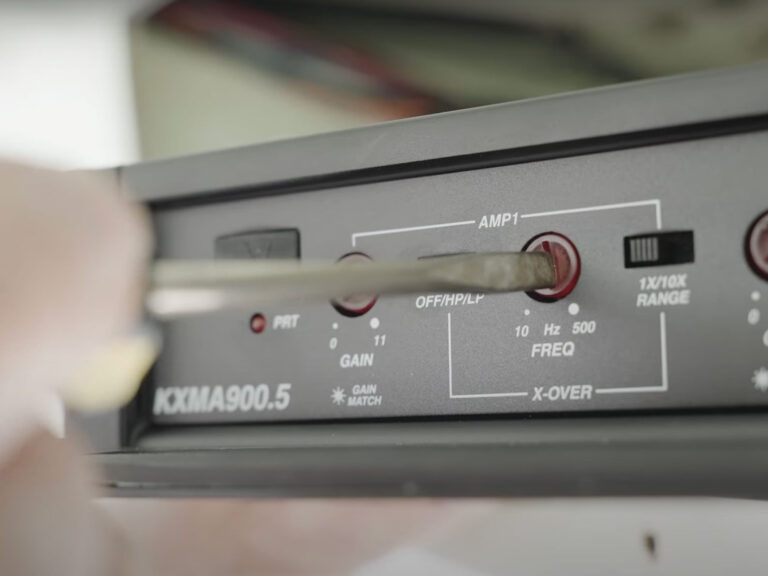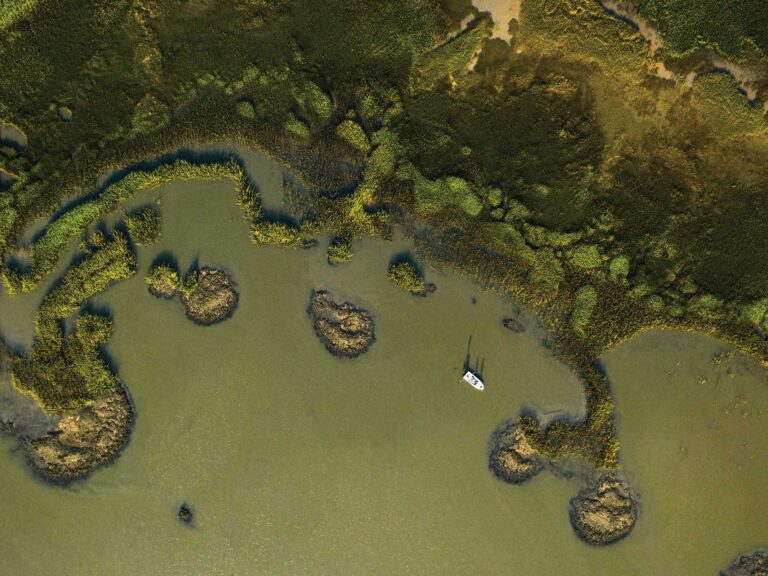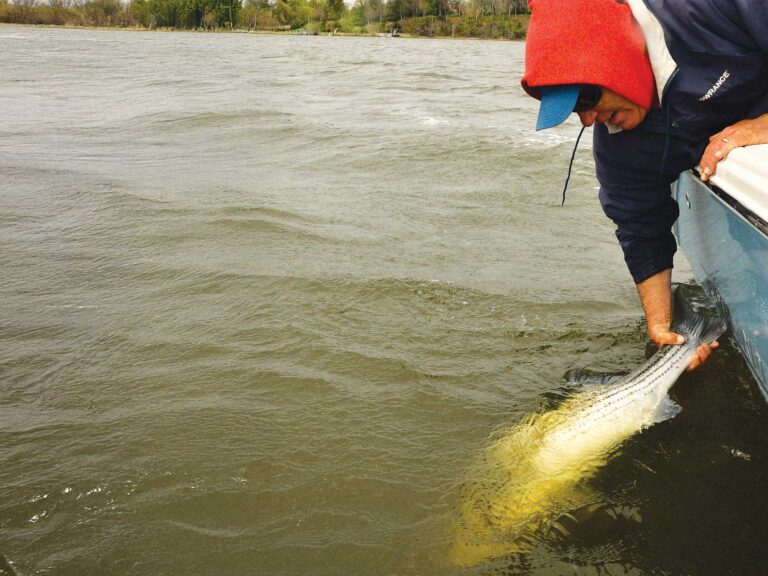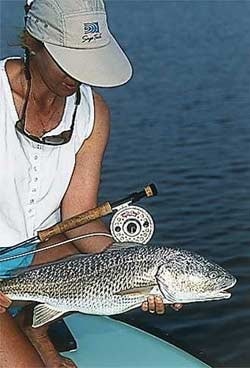
A pelican’s shadow spooked the school of redfish, but luck smiled upon us – they turned and headed right back in our direction. Capt. Warren Hinrichs cast a tight loop, dropping the weighted Seaducer directly in the path of the oncoming fish. “Let it sink,” I whispered, afraid to make too much noise.
As we watched with wide eyes, a broad tail emerged from the shallow water’s surface. “OK, now, strip,” I said. Hinrichs moved the fly, and as the line tightened he struck. A heavy charge turned into a long, powerful run. He couldn’t break the fish out of the school, and we had to pole after them with the boat. After 20 minutes or so the fish began to tire, and eventually I tailed it. It taped out at 47 inches and weighed 28 pounds – long but skinny – and we celebrated Hinrich’s biggest-ever redfish. He gave it a kiss and we watched this magnificent fish swim off.
It’s experiences like this that really make me enjoy guiding people for reds on fly. Stalking reds with a fly rod combines the finest features of hunting and fishing, requiring adroit stalking skills and the ability to successfully play a strong-shouldered fish on light fly tackle.
The Fly Fisher as Hunter
You can locate reds a number of ways, but the best bet involves hunting in shallow water from a shallow-draft skiff, powered with a push pole. It’s much like hunting deer: Does a deerstalker expect a trophy buck to walk up to him in the woods? No. He uses his senses for clues – seeing a scrape, hearing the crack of a twig, catching a scent downwind. These clues tell him a deer’s present, and the idea is much the same with redfishing.
With conventional tackle you can toss a live bait out and let it do the work of attracting fish, or cover a lot of water by blind casting with a plug or spoon, but these aren’t viable options with fly tackle. Since you shouldn’t use bait, and blind casting with a fly rod can be quite tiring, it makes sense to sight-fish for reds.
How can you detect redfish? Sometimes it’s ridiculously easy. For example, Hinrichs fishes for reds at low tide in the salt marshes around his native Jacksonville in water so shallow that the fishes’ backs are exposed as they hunt for food. You can also often hear the splashing they make when they find something to eat.
An area of muddy water appearing in an otherwise clean area should be checked visually or with a cast. Usually caused by feeding stingrays, muds often attract redfish and other species looking for an easy snack.
Most experts look for redfish extending their caudal fins into the air as they tilt their bodies in order to dig out crabs or shrimp in the bottom. Although these “tailing” fish often can be easily seen, sometimes the clue’s quite subtle, such as when the tip of the tail just barely breaks the surface. Redfish tail throughout most of their range, particularly when winds are calm. You also find fish tailing most frequently either early or late in the day.
Regardless of how you find them, once located, the stalk begins. Redfish in heavily fished waters become every bit as wary as bonefish. You must be absolutely silent in order to entertain the hope of a strike. Unfortunately, too many anglers get excited and move their feet when a red’s first spotted, spooking it. On many occasions anglers rock my boat when trying to get extra casting distance, causing little waves to travel out toward the fish – when those waves hit the fish, they usually stop tailing.
Tackling Reds
When first getting into the game of targeting reds on fly, a standard 8-weight saltwater fly-fishing outfit works well with an 8 1/2- or 9-foot rod with a matching reel. (Nothing fancier than a Pflueger Medalist proves adequate for most reds as a starter reel.) Equip that with 100 yards of 20-pound backing, a standard weight-forward floating line, a 9-foot leader tapered to 12- or 15-pound tippet and a proper selection of flies. As you become more skilled, you can graduate to lighter tackle.
Your flies should imitate standard redfish cuisine: shrimp, crabs and baitfish such as mullet, killifish, minnows and silversides. While the mouths of the bottom-feeding redfish point down, at times you can score on top-water poppers. It’s loads of fun, but you’ll do best with offerings fished near bottom. Do you need world-class casting skill to catch reds with a fly outfit? As with any other tackle, the better you cast, the more opportunities you’ll get. But if you can get the fly out there 50 feet or so – and do it with reasonable quickness and accuracy – you’ll catch plenty of redfish.
Presenting and Finessing the Fly
Once in casting range of a redfish, an accurate cast must be made. Where should you present it? This depends on the situation. Most of my fishing takes place in the Indian River Lagoon on Florida’s east coast, where fish receive heavy pressure. Usually I have to lead the reds by 2 or 3 feet and then let the fly sit on the bottom, motionless. When the fish swims near the fly, I just barely move it. Many times if the fly has any more action than this, the redfish spooks.
Capt. Danny Ayo of Thibodaux, Louisiana, finds that in Louisiana marshes, as long as the fly gets close to the fish’s head – within 6 inches or so – it’ll take it.While fishing those marshes, I had to unlearn my usual techniques. “Forget what people say about the fly approaching the fish and scaring it away,” says Ayo. “If you get it in their face, they’re gonna eat – if you don’t, they won’t.” How the fly gets into their face doesn’t seem to matter, and since Ayo’s redfish seldom see fishermen, his technique works well.
I often enjoy fishing the salt marshes north of Jacksonville, Florida. On flood tides, reds get way up into fields of Spartina grass to search for fiddler crabs. The thick grass prevents the fish from seeing very far. You have to drop the fly within inches of their head or they never see it.
When encountering a school of cruising fish, many anglers tend to drop the fly right into the pack. This usually results in the fish blowing out, since one spooked fish spooks the rest. If the fish are cruising, lead them just like you’d lead a single. If they’re milling around, try to pick individuals off the edge of the school.
The Hookup
Lady Luck soon smiles on most of us: A redfish eats the fly. Your best strategy – whether you can see what’s going on or not – involves waiting until you feel the fish. At this point, use a strip strike: Give a sharp tug with your line hand, not your rod. A strip strike sets the hook immediately, and if the fly pops out of the fish’s mouth, it’s still in the strike zone. Using the rod to set the hook pulls the fly away from the fish if the strike’s missed.
Of course, this presupposes that you pointed the rod directly at the fly to begin with. Unlike conventional tackle, all fly manipulation is done with the line hand, not with the rod. Using the rod to work the fly puts slack in the line, and makes hook setting next to impossible.
A novice fly caster in my boat one day couldn’t reach a school of fish about 50 feet away. I gently suggested that I make the cast and then hand him the rod. He quickly agreed. When he hooked the fish, he locked up the reel and the tippet popped. He didn’t realize that once hooked, a red’s going to make a hard run. Let it go. Clear the line so it doesn’t tangle on anything, and get the fish on the reel before you worry about anything else. Most redfish, even big ones, won’t run very far. Running tires them, and when they stop you can pump them in with short strokes of the rod.
The Release
Although the hero photograph of an angler with a big redfish in the boat begets bragging rights back home, the best strategy for a fish headed for release is to keep it in the water. Generally, most reds are tough and survive rough handling remarkably well, but keeping them in the water still represents the best odds of a healthy release. Grab the fish by the tail, unhook it, make sure it can swim away, and then let go. No net, no gaff, no problem.

